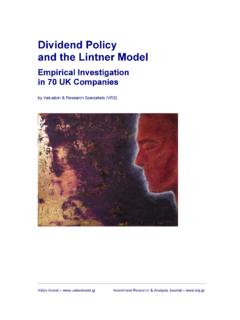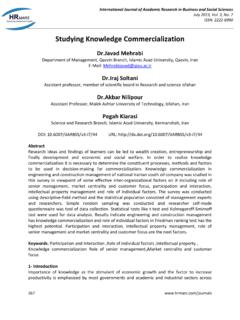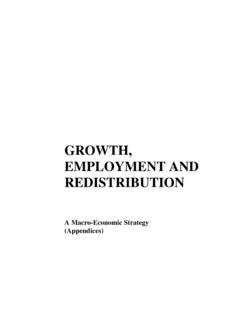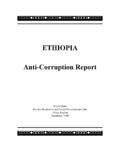Transcription of Total Environment Assessment Model for Early Child …
1 Total Environment Assessment Model for Early Child Development Evidence ReportGlobal Knowledge for Early Child DevelopmentArjumand SiddiqiLori G. IrwinClyde HertzmanTotal Environment Assessment Model for Early Child Development Evidence Reportfor the World Health Organization sCommission on the Social Determinants of HealthPrepared byArjumand Siddiqi, , MPHLori G. Irwin, , RN Dr. Clyde Hertzman, MD, M. Sc., FRCPCJune 2007 Global Knowledge for Early Child Developmentdesign: This report represents the efforts and com-mitment of many people that contributed to the team-ecd document that we would like to gratefully acknowledge: the Members of the Knowledge Network for Early Child Development, S. Anandalakshmy, Marion Flett, Mary Gordon, Abeba Habtom, Sarah Klaus, Ilona Koupil, Cassie Landers, Beatriz Londo o Soto, Helia Molina Milman, Dr.
2 Bame Nsamenang, Dr. Frank Oberklaid, Alaa Ibrahim Shukrallah, Nurper Ulkuer, Camer Vellani, Annah Wamae, and Mary Eming Young. We would like to extend a special thanks to Meena Cabral de Mello, Senior Scientist, World Health Organization Department of Child and Adolescent Health and Technical Officer for Early Child Development, for her input, review of previous drafts, and commitment to this work. We would also like to thank the University College London Secretariat Members, Ruth Bell, Tanja Houweling, and the Geneva Secretariat Knowledge Network Coordinator, Sarah Simpson, whose patience and expertise has ensured that our work integrates with the broader goals of the our Commissioners, the Hon. Monique Begin, Stephen Lewis, William Foege, Alireza Marandi, and Denny V ger , we thank you for championing the recognition of the impor-tance of the social determinants of health and for committing to moving this work from knowledge to would like to acknowledge the input we received from experts such as Alan Kikuchi-White, Alan Pence, and Ilgi are also grateful to our colleagues at the Human Early Learning Partnership (help) for their contributions to earlier versions of the team-ecd document: Iraj Poureslami, Emily Hertzman, Robin Anderson, Ellen Larcombe, Eric Hertzman (cartographer), Abhaya Srivatsan, Stefania Maggi and Shawna Reibling.
3 And to those col-leagues whose unending support made this work possible: Jacqueline Smit Alex, Leslie Fernandez and Sophia , we want to extend a special thank you to Karyn Huenemann for her editorial expertise, to Maria LeRose for her contribu-tions of synthesizing complex information and making it accessible to a broad audience ( ), to Shannon Harvey for her creative This work was made possible through funding provided by the P ublic Health Agenc y of Canada and undertaken as work for the Early Child Development K nowledge Net work, established as part of the who Commission on the Social Determinants of Health. The views presented in this work/publication/report are those of the authors and do not necessarily represent the decisions, polic y or views of who or CommissionersTable of ContentsExecutive Summary 3 Introduction and Overview 11 figure 1 : team- ecd schematic 15 The Individual as a Sphere of Influence 19 The Family as a Sphere of Influence 2 9figure 2 : socioeconomic gr adient s in stunting among three andean countries 3 4 The Residential Community as a Sphere of Influence 4 1figure 3 : socioeconomic gr adient s in infant and Child mortalit y in kenya 3 6 figure 4 : socioeconomic gr adient s in childhood diarrhea within slums in nairobi and within rur al areas of kenya 3 6 figure 5.
4 Child friendly cities 45 The Relational Community as a Sphere of Influence 47 The ecd Services Sphere of Influence 5 1 The Region as a Sphere of Influence 63figure 6: Early development instrument vulner abilit y map 6 4 The Nation as a Sphere of Influence 67 The Global Environment as a Sphere of Influence 7 7 Discussion and Conclusion 8 9 Appendix A 91 Appendix B 93 Appendix C 9 4 Appendix D 9 9 References 101 Chapter 1 Chapter 2 Chapter 3 Chapter 4 Chapter 5 Chapter 6 Chapter 7 Chapter 8 Total Environment Assessment Model for Early Child Development3 Executive SummaryThe Early Child period is considered to be the most important developmental phase throughout the lifespan. Healthy Early Child development [ecd] which includes the physical, social emotional, and lan-guage cognitive domains of development, each equally important strongly influences well-being, obesity/stunting, mental health, heart disease, competence in literacy and numeracy, criminality, and economic participation throughout life.
5 What happens to the Child in the Early years is critical for the Child s developmental trajectory and lifecourse. The principal strategic insight of this document is that the nurturant qualities of the environments where children grow up, live, and learn matter the most for their devel-opment, yet parents cannot provide strong nurturant environments without help from local, regional, national, and international agencies. Therefore, this report s principal contribution is to propose ways in which gov-ernment and civil society actors, from local to international, can work in concert with families to provide equitable access to strong nurturant environments for all children glob-ally. Recognizing the strong impact of ecd on adult life, it is imperative that governments recognize that disparities in the nuturant environments required for healthy Child development, will impact differentially on the outcome of different nations and societies.
6 In some societies, inequities in ecd translate into vastly different life chances for children; in others, however, disparities in ecd reach a critical point, where they become a threat to peace and sustainable Early years are marked by the most rapid development, especially of the central nervous system. The environmental conditions to which children are exposed, including the quality of relationships and language Environment ,[in the earliest years] literally sculpt the developing brain. The environments that are responsible for fostering nurturant conditions for children range from the intimate realm of the family to the broader socioeconomic context shaped by governments, international agencies, and civil society. These environments and their characteristics are the determinants of ecd; in turn, ecd is a determinant of health, well-being, and learning skills across the balance of the lifecourse.
7 The seeds of adult gender inequity are sewn in Early childhood. In the Early years, gender equity issues in particular, gender socialization, feeding practices, and access to schooling are determinants of ecd. Early gender inequity, when reinforced by power relations, biased norms, and day-to-day experiences in the family, school, com-munity, and broader society, go on to have a profound impact on adult gender inequity. Gender equity from Early childhood onwards influences human agency and empowerment in adulthood. Economists now assert on the basis of the available evidence that investment in Early childhood is the most powerful investment a country can make, with returns over the lifecourse many times the size of the original scope of the present report is fourfold:1.
8 To demonstrate which environments matter most for children. This includes environments from the most intimate (family) to the most remote (global).2. To review which environmental configurations are optimal for ecd, including aspects of environments that are economic, social, and physical in To determine the contingency relationships that connect the broader socioeconomic context of society to the quality of nurturing in intimate environments such as families and communities. 4. To highlight opportunities to foster nurturant conditions for children at multiple levels of society (from family-level action to national and global governmental action) and by multiple means ( through programmatic implementation, to Child -centered social and economic policy development).
9 In keeping with international policy standards, Early childhood is defined as the Executive Summary4period from prenatal development to eight years of age. The evidentiary base, as well as interpretation of the body of evidence, is derived from three primary sources: 1) peer-reviewed scientific literature, 2) reports from governments, international agencies, and civil society groups, and 3) international experts in the field of ecd (including the Commission on Social Determinants of Health Knowledge Network for ecd) that is representative in both international and inter-sectoral terms. This evidence-based multiple-sourced approach ensures that the conclusions and recommendations of this report are borne out of the perspectives of a diverse array of stakeholders and are thus broadly applicable to societies throughout the guiding principle is an equity-based approach to providing nurturant environ-ments for children everywhere.
10 Multiple perspectives from the provisions of human and Child rights declarations to the realities reflected by research evidence make clear the importance of equity. Programs and policies must create marked improvements in the circumstances of societies most disad-vantaged children, not just in absolute terms, but in comparison to the most advantaged children as well. What is now known is that, in every society, inequities in socioeconomic resources result in inequities in ecd. The relationship is much more insidious than solely differentiating the rich from the poor; rather, any additional gain in social and economic resources to a given family results in commensurate gains in the devel-opmental outcomes of the children in that family. This step-wise relationship between socioeconomic conditions and ecd is called a gradient effect.

















